In this article, I would like to state my opinion on a six-color photo. epson printer L800. The L series from the manufacturer indicates that the printer is equipped with a factory CISS. The manufacturer calls such a device a "printing factory". There are quite a few reviews of this printer on the Internet. Therefore, here I will not delve into specifications, but I will tell you why the L800 is generally needed and how expedient it is to buy it. I repeat, this is just my own opinion and I, in no way impose it on others.
Let's take a quick look at what kind of device it is.
The Epson L800 comes in a plain gray cardboard box, like all L-series devices.
Includes: power cable, waste paper, driver disc, several sheets of photo paper, tray for printing on discs, and six cans of Epson ink.
According to the good old tradition USB cable did not put inside. What for? If you forgot to warn the store about its absence - that's okay. We came home, unpacked the printer and went back to the store for the cable - walking is good for your health.
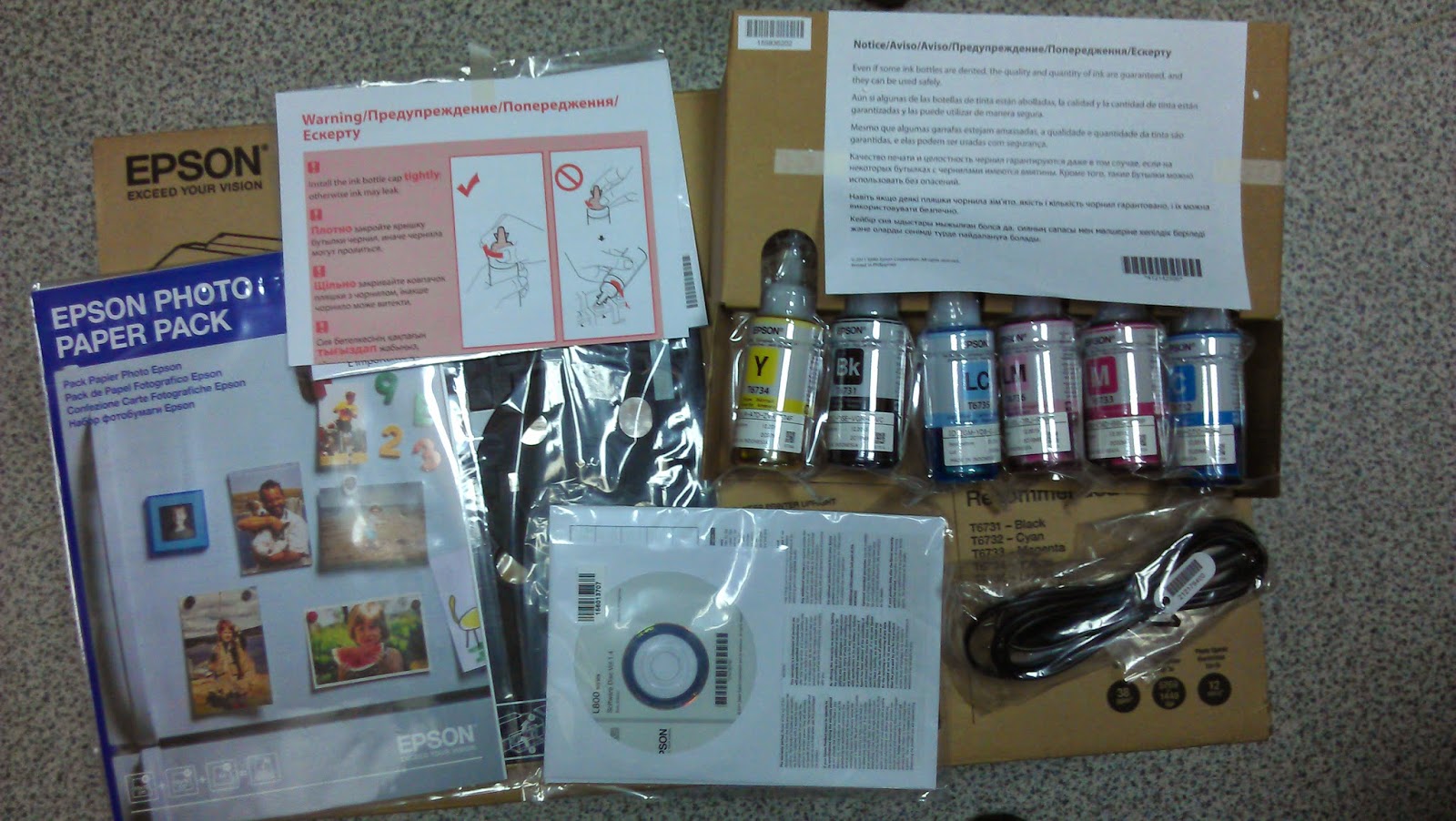
This is what the printer looks like from above. A block of donor containers is attached to the right.
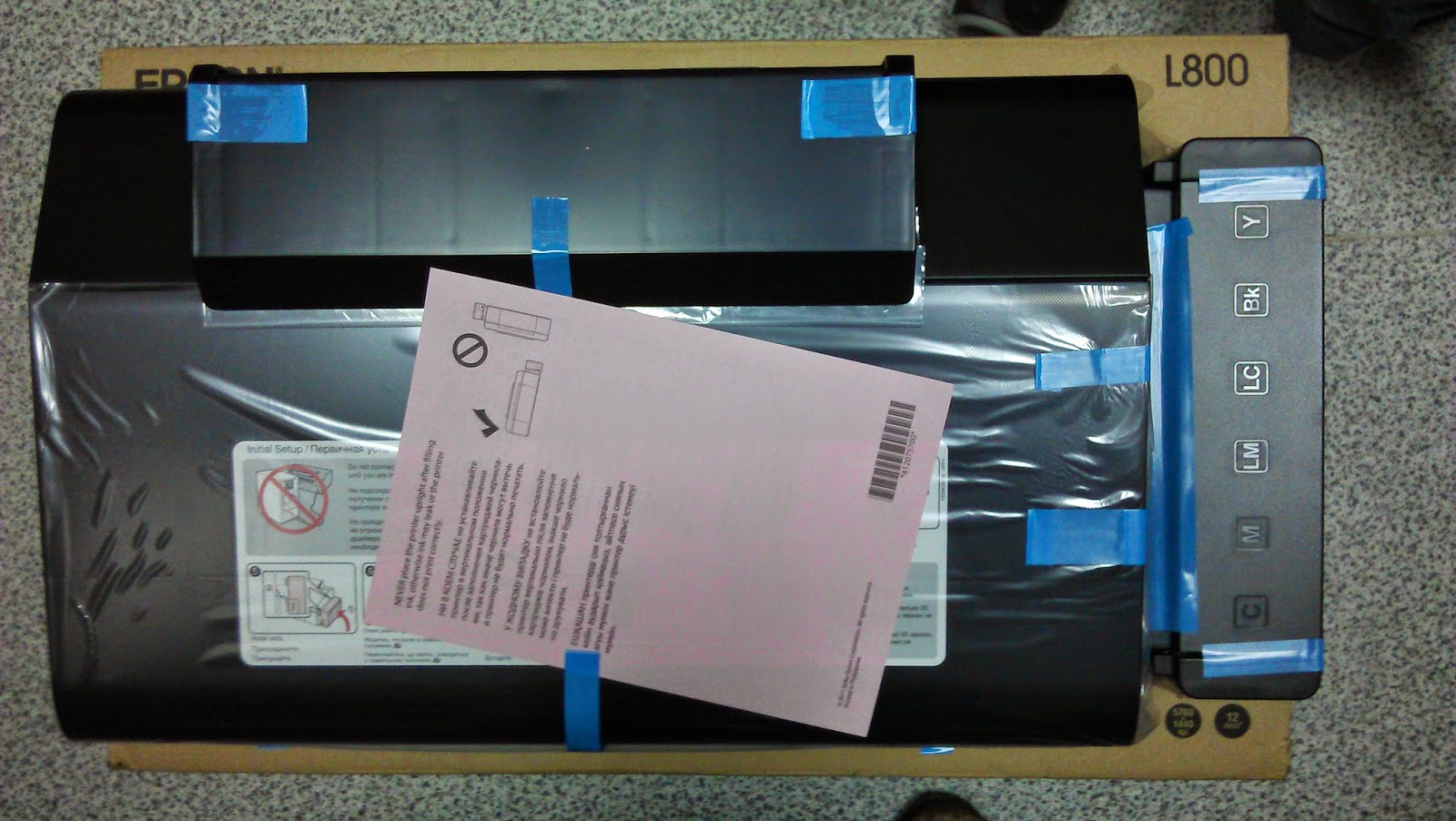
Naturally, there is no board for identifying the chips of ink tanks. But this does not mean that the device will allow the use of non-original ink.
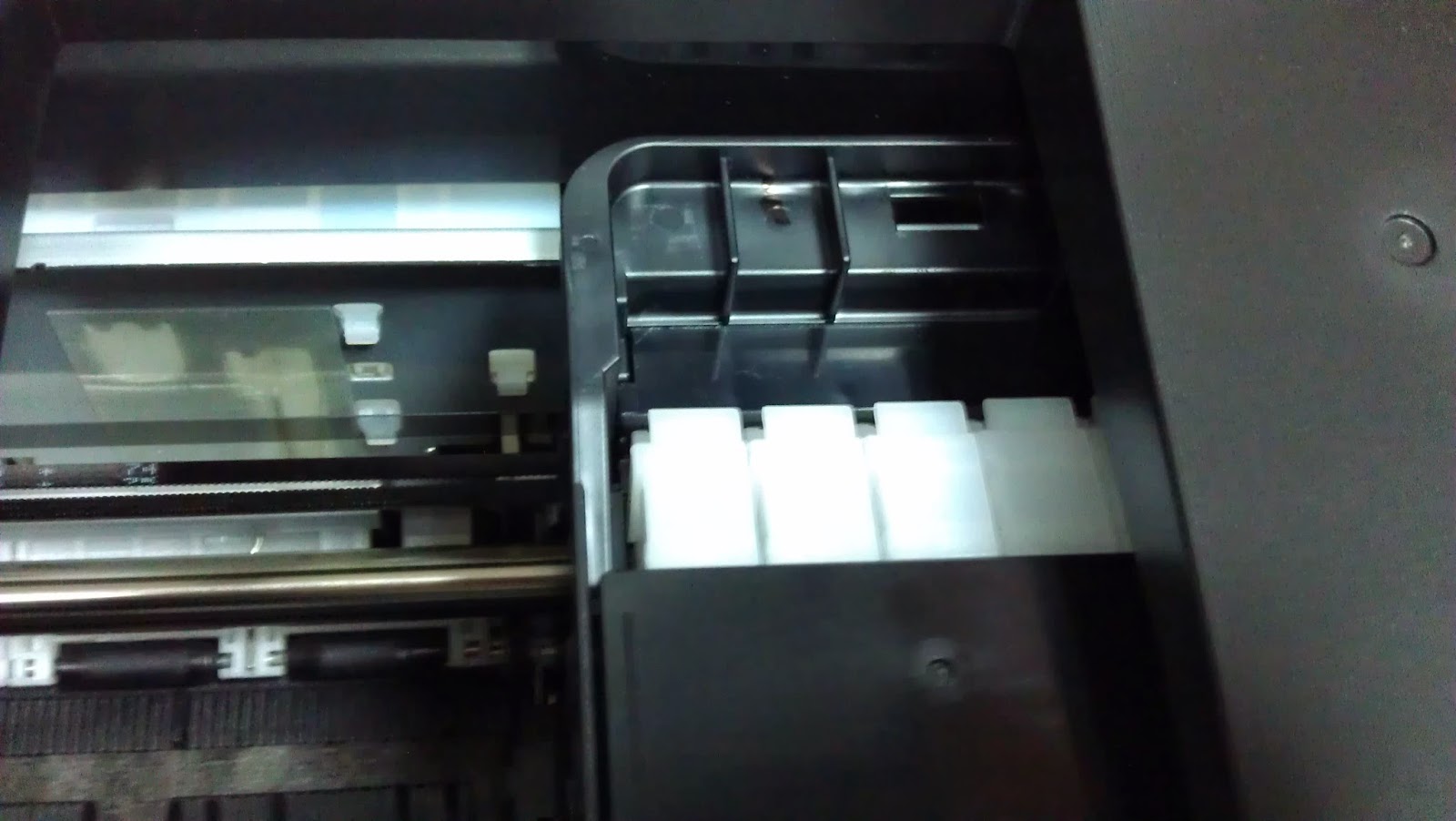
CISS tubes are quite thick and soft, made of high quality.

The donor containers are covered with a lid.

We open it. On the back of the cover there is an instruction on how to properly handle the ink tanks.

There is a transport and working position switch on the side of the unit. When you use the device, do not forget to set the switch to the working position. Otherwise, your printer may have big printing problems. In the transport position, it is commonplace, the tubes are pinched and, thereby, ink access to the printer is blocked.
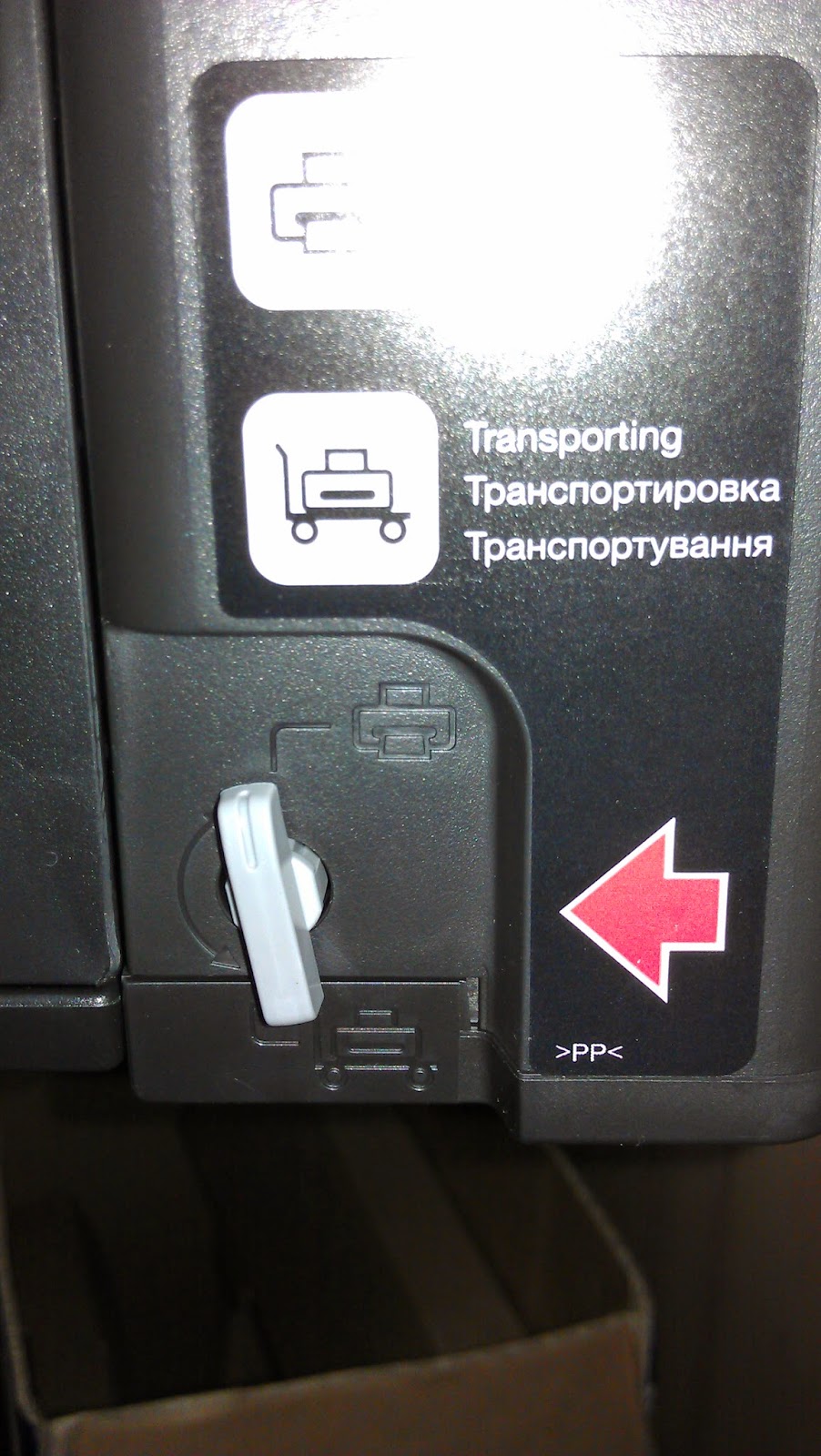
In order to detach the ink tank unit from the printer, simply lift it up.

Ink fill holes covered with paired rubber plugs
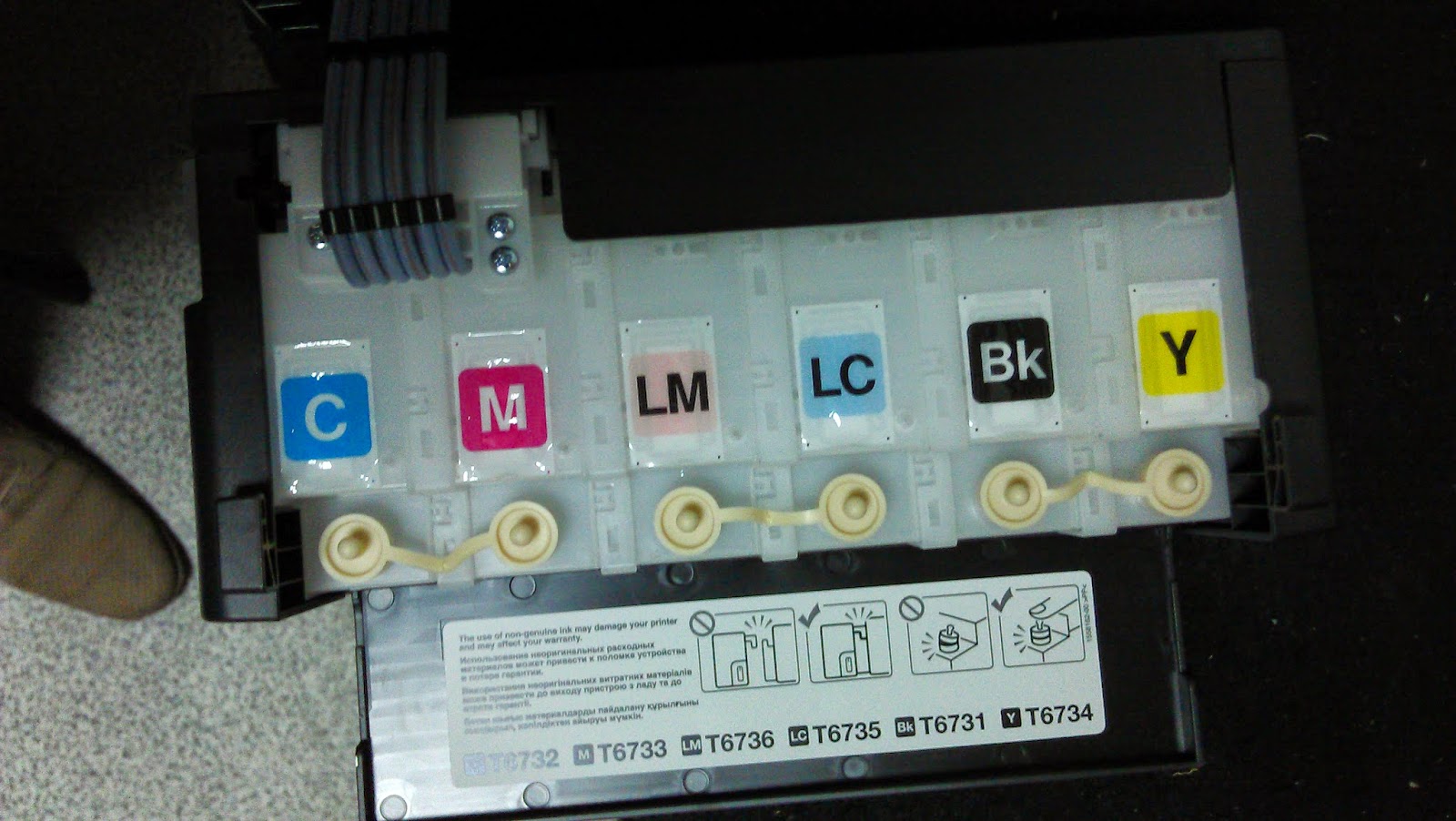
Above, on the printer cover is glued detailed instructions how to start the device for the first time.

Each ink can contains a code that must be entered when initializing the printer. This protects against the use of non-original ink. The capacity of the jar is 70ml.
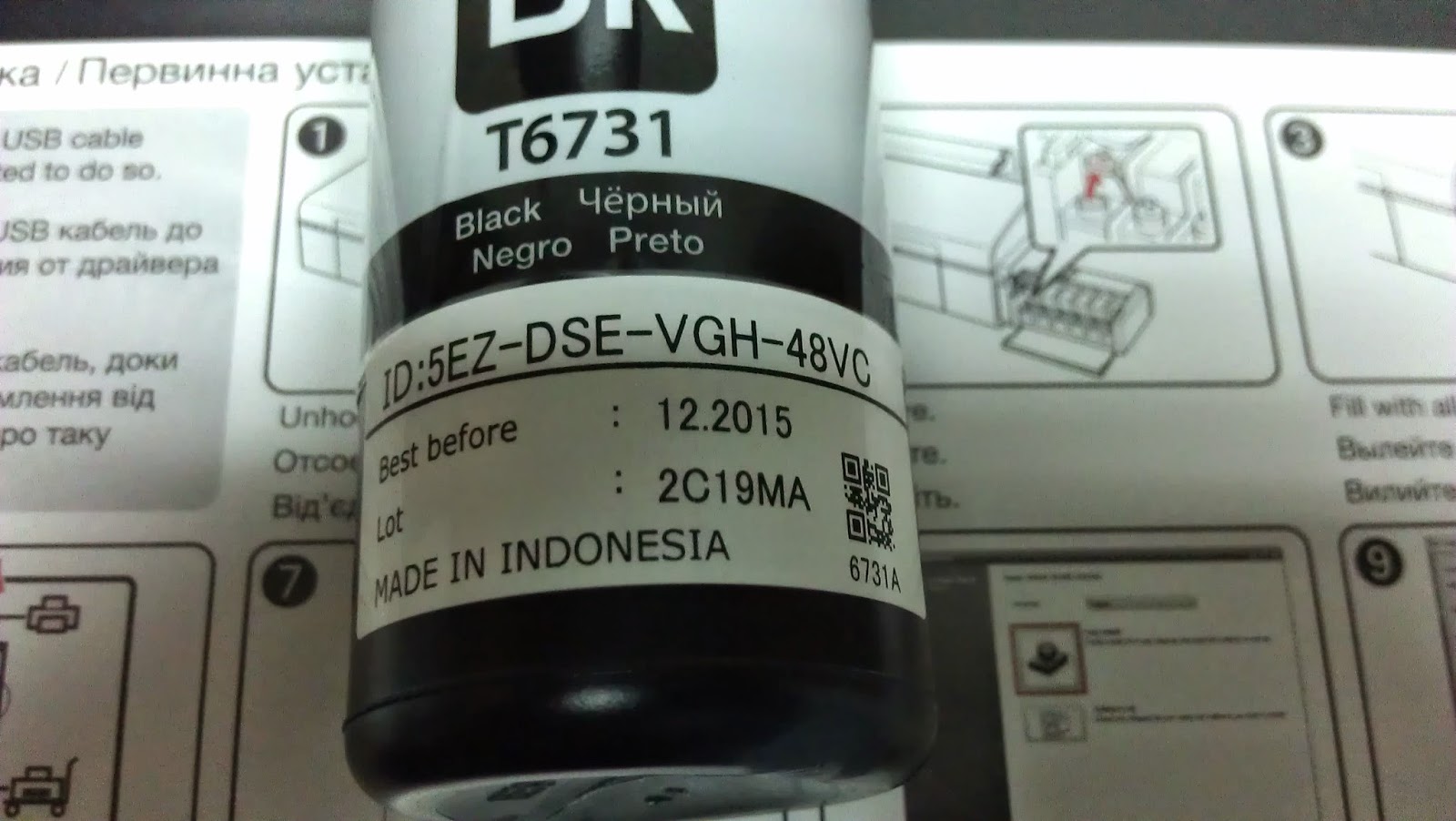
tylus Photo P50 (as well as R290, R295, T50) on which the factory CISS is installed. That is, this is an analogue of a rather successful model, in which practically nothing has changed for a long time.
So which is better to get the L800 or the P50? Is it worth overpaying for CISS from the printer manufacturer?
Initially, the difference in price between these two printers seems to be quite significant - 50-70 USD. But please note that on P50 You will definitely have to install CISS (well, or purchase refillable cartridges). Add to the costP50 the cost of CISS and installation. Now the difference betweenL800 and The P50 is not so big - about 15-20 USD.
For this money, you get a high-quality CISS, which is practically devoid of such problems as airing, pressure drops in the system and others, which are often "sinned" by cheap (and not so) systems from third-party manufacturers. You also get the opportunity to print original ink... In addition, the original ink does not dry out so quickly in the print head when the printer is idle for a long time without printing.
Many people complain about the high cost of original ink. Yes, indeed, genuine L-series inks cost about seven times more than regular third-party inks. But, firstly, if you buy a printer for home use, they will last you for a long time. And if for a commercial - their price will pay off. Secondly, no one bothers you to use compatible consumables, which are much cheaper. But what about protection, but what about the codes on the cans? Now there are quite a few programs on the Internet for generating these codes. For example PrintHelp.
Although, frankly, I am against using alternative supplies specifically for the L series of Epson printers. At the same time, you save a little money, but you lose more than half of the benefits that I wrote about above.
Summing up, I would like to inform you that Epson printers with factory CISS are quite competitive products. Choosing between a "printing factory" and a similar device without CISS, I would prefer the first option.
I am often asked which ink is the best to use in the Epson L800 printer. Everyone has to talk about the pros and cons of a particular ink. And so I decided once to write my personal feelings about using ink from three manufacturers on the Epson L800, which I have been using for almost three years. This printer was purchased as soon as it went on sale. Original epson ink I did not fill it in and therefore I cannot compare with them. But for me it is not the comparison itself that is important, but obtaining a high-quality result at a low cost of photographs.
Immediately after buying the printer, I filled it in. At that time, they were actively gaining popularity in our market. As a person who loves experiments, I decided to try this ink as well. Despite their high cost. Although, once again, I would like to draw your attention to the fact that I would like to get a lower cost of printing on my Epson L800.
To be honest, the first impression was ambiguous. After refueling, the printer immediately printed a perfect nozzle test. There were no problems with this. But here's the color rendering ... She immediately caused some disappointment. All photographs on all types of paper had a strong green tint. I don't like to use profiles, so I decided to try to adjust the colors through the standard settings of the printer driver. In general, I was able to achieve a more or less acceptable result. But it was far from ideal.
I didn't want to change the ink, despite the average color rendering quality. lazy. I decided to use them up. Which I managed to do in about six months, periodically printing photographs and looking longingly at their color rendition.
Six months later, spring came and the child in kindergarten it was necessary to print many different photographs, diplomas, certificates, etc. OCP ink By this time I ran out and I decided to fill in the ones that were tested on my previous Epsons. Naturally, I previously removed the remnants of OCP from containers and cartridges using a syringe. CISS did not rinse, but simply filled with InkTec. I made several regular cleanings and again got 100% of the nozzles on the test. But this is not what made me happy. Color rendition is much better! The faces are no longer blue-green.
To be fair, it should be noted that the color reproduction was not perfect with InkTec either. The shades went into warm colors. But it's much better than the cold OCP. Especially if the photo contains people's faces. Complexion looks more natural with InkTec ink.
I'm one of those people who like to experiment. And therefore, after the InkTec ink ran out, I decided to try another ink known in our country. It . Here I digress a little and note that I did not notice the difference with the EIM-290 series and I assume that these are the same ink, but with different markings.
I will continue about. Pre-draining the rest of InkTec ink from CISS and cartridges, I filled in new ink. Dropped everything presets in the driver and started a test print. The nozzles are again 100%. But this has become a common thing, and therefore I believe that all manufacturers in this regard have learned how to make good ink.
But the color rendition was very pleased with the very first photo. I didn't set up anything, I just printed the photo on super glossy photo paper. I was 100% satisfied with the quality. I decided that in the future I will stay with this ink, despite the fact that it is a little more expensive than InkTec. But they are much cheaper than OCP, which I was very disappointed with when using in the Epson L800.
There were also no problems with streaming printing. 20 A4 photos printed in a row did not reveal any problems.
As a result, I would like to say that there are practically no problems with clogging of nozzles on modern ink. But each manufacturer has its own color perception. Most of all, I liked the color reproduction on the Epson L800 with. If you are not ready to overpay for this, then I recommend opting for. And if you want to get photos in blue-green tones and pay extra for the name, then your choice is OCP ink.
Hello! Please, I ask you to help me. I have l800, as I got it, I actively used it, it worked perfectly without any complaints. For a year now, I had it idle, so everything was dry, I did cleanings, I even took it to the workshop for repairs and cleaning the head, changed colors, and washed them in the workshop. The nozzle test shows all the norm, but when I print a photo on a photo where black colors are covered with red grain, and the quality of the photos leaves much to be desired, even when printing an "improved photo". I went to all the workshops, they can't say anything, they don't even want to take it.
Hello, a thin purple stripe appeared when printing a photo, the ink is original, there is no photo paper, the stripe is gone after cleaning the PG, but there are other barely noticeable stripes throughout the image, what is the best way to do it?
You need to do a couple of cleanings at intervals of 1-2 hours. If the stripes have not gone leave the printer for 12 hours. Then it is enough to do one more cleaning, all the colors should appear. No more than 2-3 cleanings per day with an interval of 1-2 hours. If the ink is old, up to one year in CISS, drain, flush the system, replace with new ones. If the alternative ink is filled in and it is about half a year old, drain, flush the system, refill with fresh ink.
Hello, on the nozzle test, the blue flows into red, the flushing by mister muscle stopped helping. If this is a depressurization, why is it so fast, the printer is only a year old, printed no more than 1000 photos. I gave 20,000 for a new printer, now pay 11,000 more for the GHG? Expensive. Ink + paper - more than 50 rubles per print.
This model frequent problems with PG, a lot of marriage. why the MM was washed is not clear. If you write about Epson photo paper, then it is, yes, dear. But there are many alternative photographic papers, many times cheaper. Buy paper and ink through an online store, prices there are not as biting as in a store. You can find original ink at the "flea market", even cheaper, the local forum of your city to help.
Prompt analogs of photographic paper, if not difficult.
1 more answerRebzya, who is smart here? As far as I know, the codes are written on the ink. And what about his left ink? How to fill them without codes? I can’t find the information anywhere. In this regard, another question is - what is better to buy an Epson L800 or Epson P50 with CISS? It's just that CISS has a jamb - you need to reset the cartridges with a button, and the printing stops in the middle of the sheet and the sheet has to be thrown away. I would be grateful for a detailed answer.
There is such a judgment: "the P50 always runs out of ink, and the L800 always runs out of paper." If you print a little, then P50 with PZK (redirected cartridges) If you install CISS, you can buy an unbalanced CISS, such CISS have problems with ink supply. There used to be a NANO chip, ink reset at any time, now I don't know if they are.
On the L800, the code is entered only for the first start; there is no need to enter the codes later. Codes from jars are a dime a dozen. Printhelp program (download in the internet) reset the ink level at any time, reset all cartridges.
new printer. worked for less than six months. printed a little. after printing a photo with a bright orange background and in a frame, I began to make yellow-green stripes. We cleaned the head 2 times automatically, the test got worse and now everything is in stripes and pink. what to do?
What ink is injected? do one cleaning, wait thirty minutes, print a nozzle test, if it's bad, do another cleaning, wait an hour, print a test, if it's bad, turn it off until tomorrow. The next day, print a nozzle test if it is again bad to do two cleanings in a row. For the future, there is an interval of up to an hour between cleanings, preferably no more than 3-4 cleanings per day.
native ink. did the cleaning 3 times. test with bald spots anyway. and the ink is not very much used up?
1 more answerPut the CISS on its side, as for refueling, open the plugs, let it stand for a couple of minutes, close the plugs, put the CISS in place, do a couple of cleanings with an interval of 20 minutes, print the test. If it does not help, then after about an hour, clean the steam generator with open plugs. Yes, ink will be used up.
tell me, does it print with fields? is it possible to print without borders without Photoshop?
The printer comes with a driver disk and software for photo processing and printing. You can print from any graphics program, the choice of the mode of printing with borders, or without borders, you choose yourself in the printer driver, in the same place you select the paper type and print quality.
i don't understand you people. I bought the L800 almost a year ago. he has already printed 111,000 prints in a wide variety of formats. 70% 10x15 20% A4 and 10% A5 and still continues to print great quality prints. and he's not even going to die. and there were never any complaints in the work.
If original ink was poured into my system, can I replace it with INKSYSTEM and how to do it?
Keep ink residues to a minimum, then fill in alternative ones. As soon as you fill in the alternative ink, congratulations on the hemo ... m. After a couple of months, color loss and color shade mismatches in the photo will torment. Throw out the printer in a year and a half.
1 more answer
Color and shades are different things. If the printer is at home, the probability of color dropout when printing photos on alternative inks increases several times compared to the original ink. + frequent cleaning with alternative inks, which after about a year and a half leads to depressurization of the steam generator. Several friends who bought a printer at about the same time went through this myself. They threw out their pr. At about the same time. It worked for me for 3.5 years. I typed relatively a lot, compared to my friends. Everyone used the viola. ink from different manufacturers. Someone filled in expensive, some cheap ink, all have one end, the printer in the trash.
If you naively thought that the L800 would turn out to be something unseen, striking the imagination and generally a new word in design printing technology, repent. The Japanese have once again followed the path of least resistance: L800 is not a novelty (at least in the correct sense of the word); this is just the familiar Epson Stylus Photo T50 (or P50), to which the most ordinary CISS dressed in black plastic was attached.
"Fiftieth" and before was not a model of compactness, and now even more so. The revolutionary printer is too bulky to fit easily on a mid-sized computer desk. And it is impossible to mount it far from the PC: in tribute to the T50, the developers did not provide our hero with either Ethernet or Wi-Fi.
A quick glance under the lid of the device, however, reports that if Epson's engineers had gone to a few construction tricks (for example, to place ink tanks not in a single block, but in two or three), the hopes of users would have been justified. Back in the days when there were only rumors about the L800, only the lazy did not predict that Epson would still find an ergonomic and compact way to place the CISS inside the case, and not outside. But alas.
The very same proprietary continuous ink supply system only shines with a glossy cover. The quality of its workmanship is certainly not better than most of the models on the market, and even worse in comparison with some particularly successful specimens. However, refueling it is just as convenient, and in case the printer is transported, it has a special lever to stop the ink supply (you have to block third-party systems by closing the hole on each of the ink tanks with a special lid).
But the printer itself makes a good impression (in fact, like its predecessor Epson T50). It is made of thick plastic - therefore heavy and durable; practically devoid of easily soiled gloss (shiny panels are covered with fine corrugation, the rest are matte) - therefore practical; in cross section contains a bizarre pentagon - therefore, it is outwardly original.
The control panel, if you can call it that, consists of just three buttons with LED indicators: power on / off, ink refill, and job cancel. Released in the second half, for a moment, 2011, the revolutionary L800, alas, does not support stand-alone modes at all, cannot print directly from memory cards and cameras (due to the lack of a built-in card reader and PictBridge support), not a bit interactive (Epson was not even born monochrome screen, but speaking about color).
Yes, we praised the Epson T50 for this and almost lifted it to heaven, they say, the amount included in the cost was spent on a solid printing system, and not on any nonsense. But, despite the external and mostly internal similarity, T50 and L800 are different (at least from a market point of view) printers with different target audience. Nobody hides that the T50 is primarily a home photo printer and is intended for those professionals who have not yet managed to save money for a professional unit of the Epson R series. But the L800, on the contrary, is a corporate printer, as local marketers say on the official Russian website of Epson designed for photo salons and photo labs. A bit of feigned manufacturability wouldn't hurt him.
However, let's return from free philosophizing to a detailed review. appearance... So, the next step is the receiving tray and the feeding tray. They are separate, organized according to the classic and, in our opinion, one of the most successful schemes "vertical feed chute on the back of the case, horizontal intake on the front side." The capacity of the input tray is sufficient: up to 120 sheets of ordinary office paper or up to 20 sheets of photo paper. It is not possible to feed different media separately. Just above the output tray, which holds up to 50 pages of prints (on plain office paper), is the CD tray.
Let's summarize. Outwardly, the L800 is pleasant and all that, but not quite this was expected of it. Rather, this too, but in a different performance. It's one thing to "update" the lineup, adding a dozen or two units to the digital index of the old model, and supposedly represent a new printer (this was the case with the T59). This is also, frankly, not very cool, but to open a new series of printers, and even with a claim to be revolutionary, with a well-known device, interrupting numbers on it and hastily attaching a medium-quality CISS to it - this, as they say, is generally for the line between good and evil.
